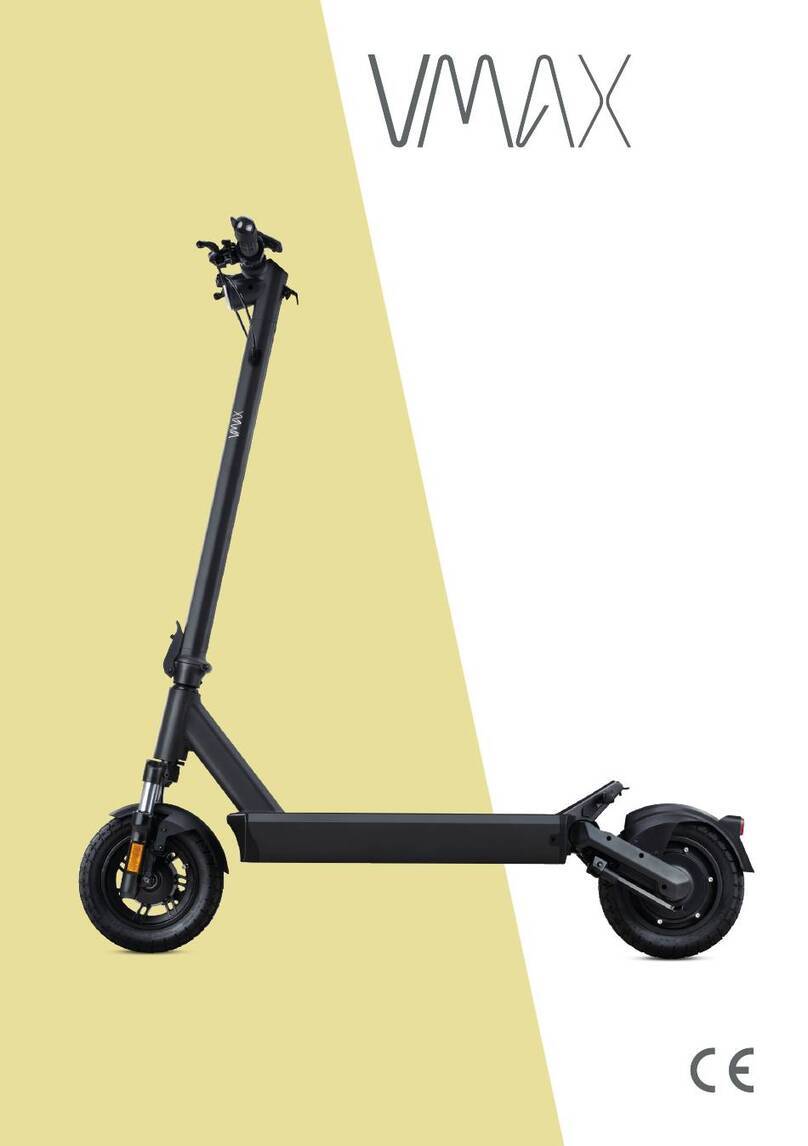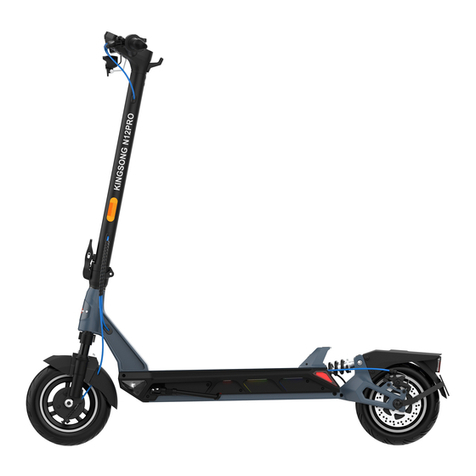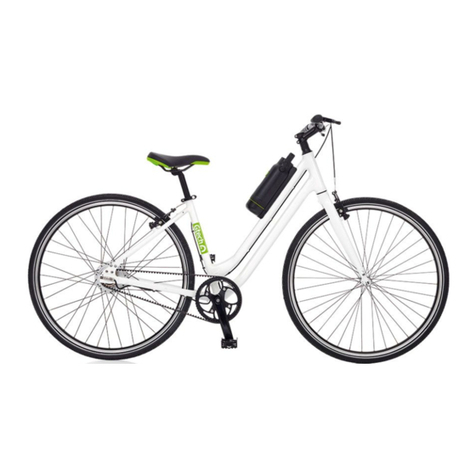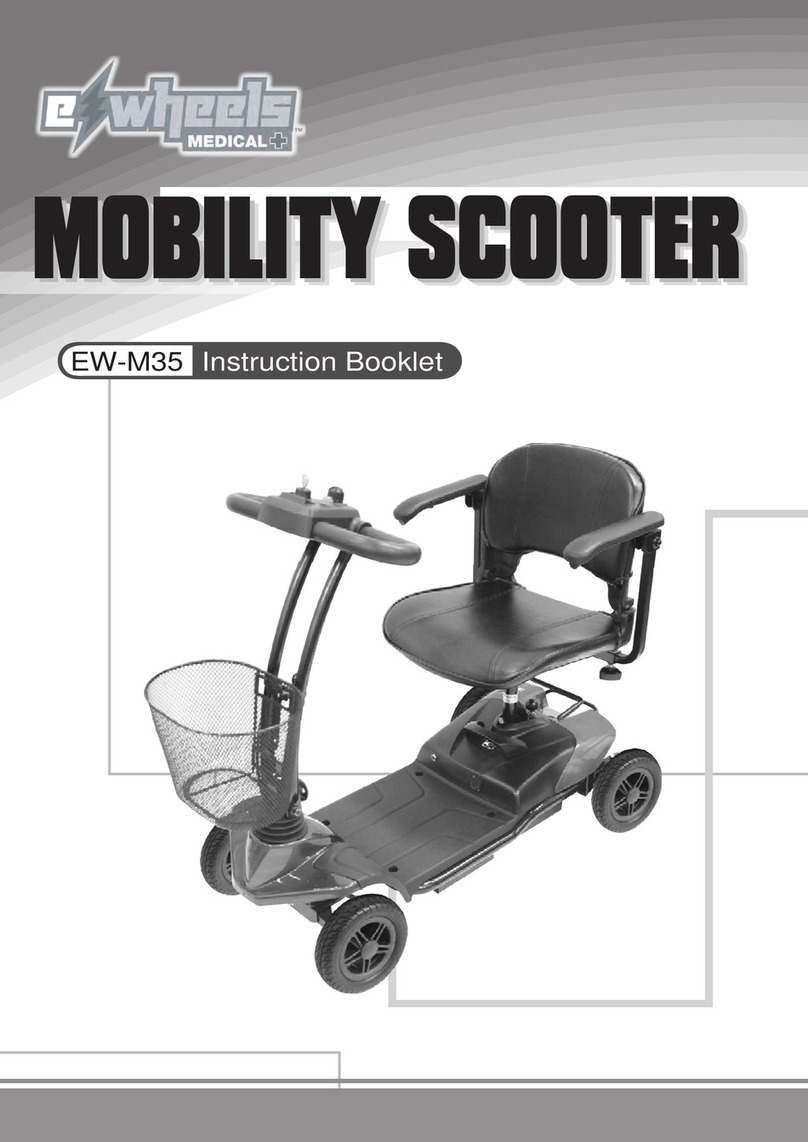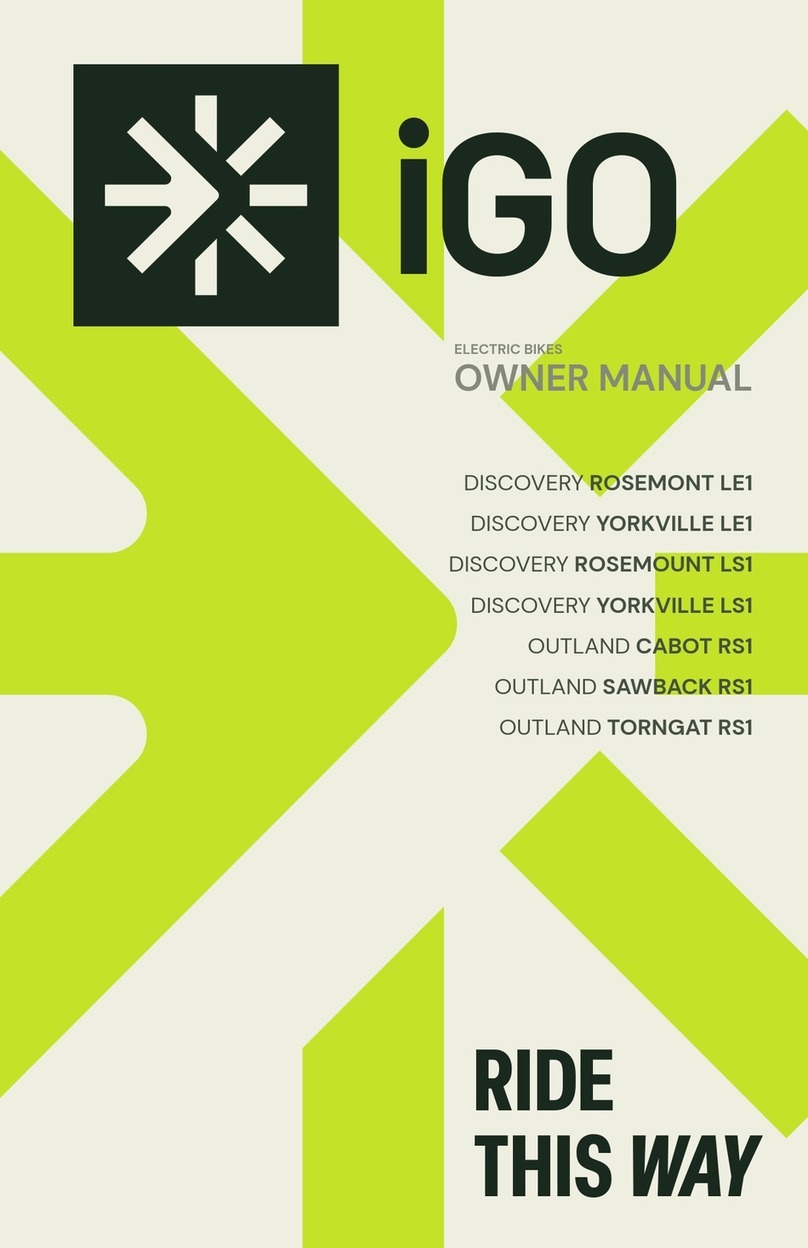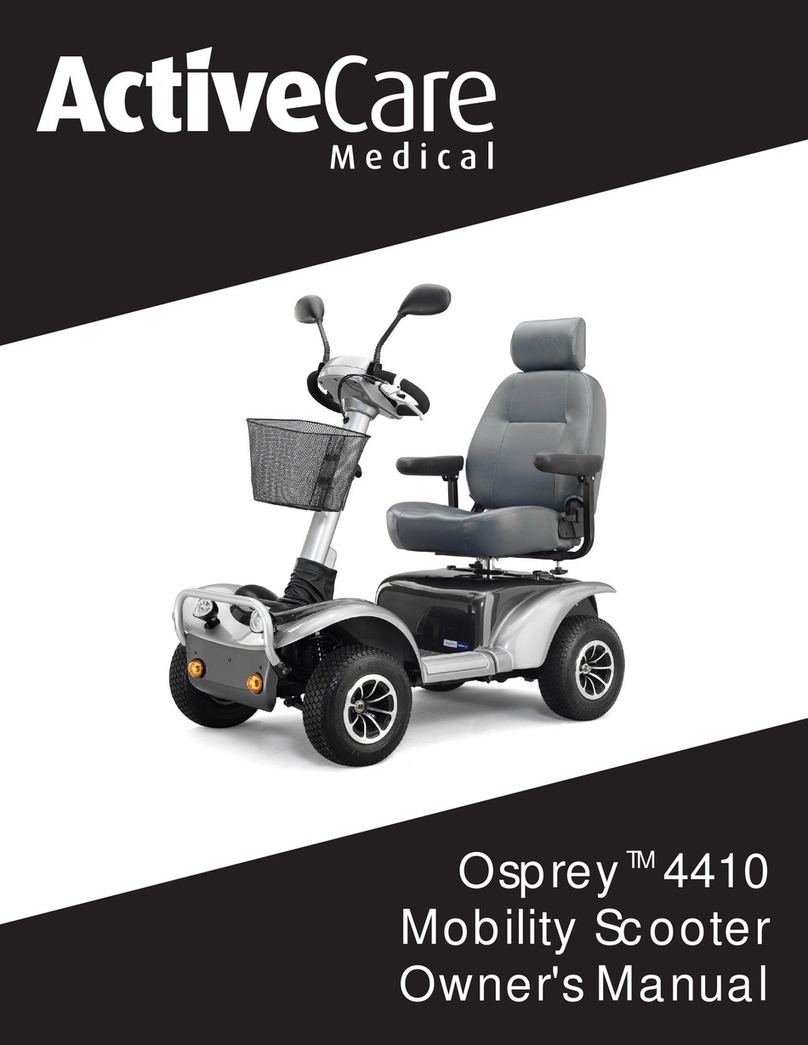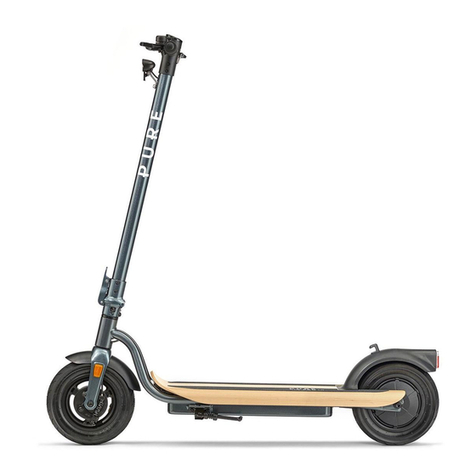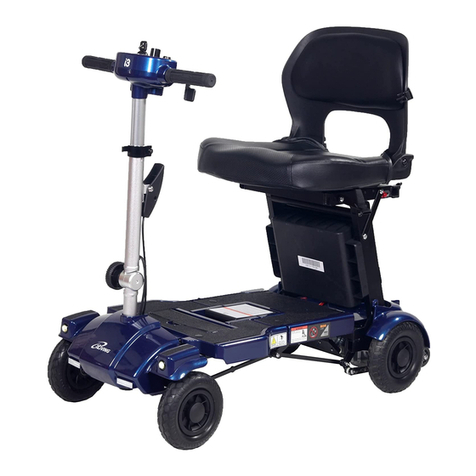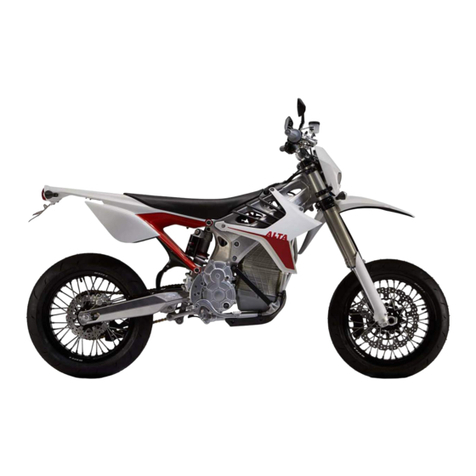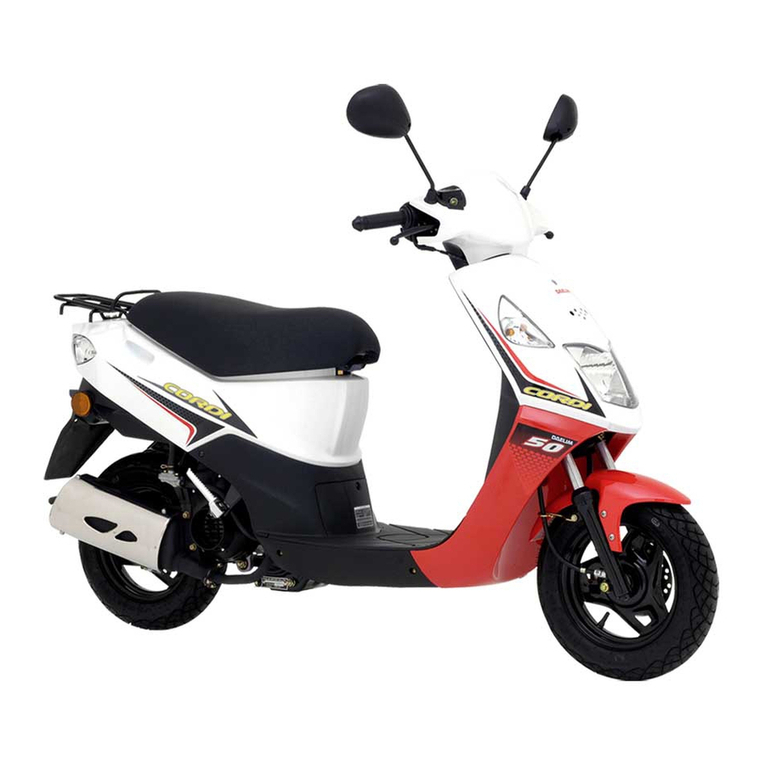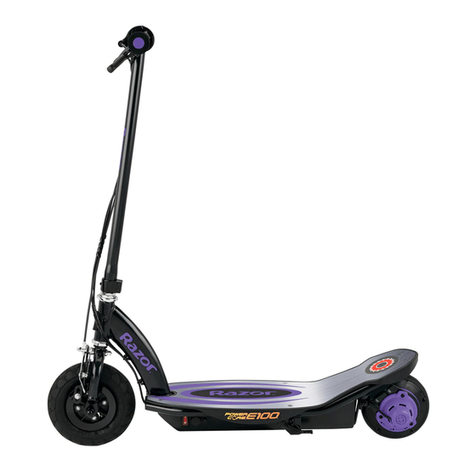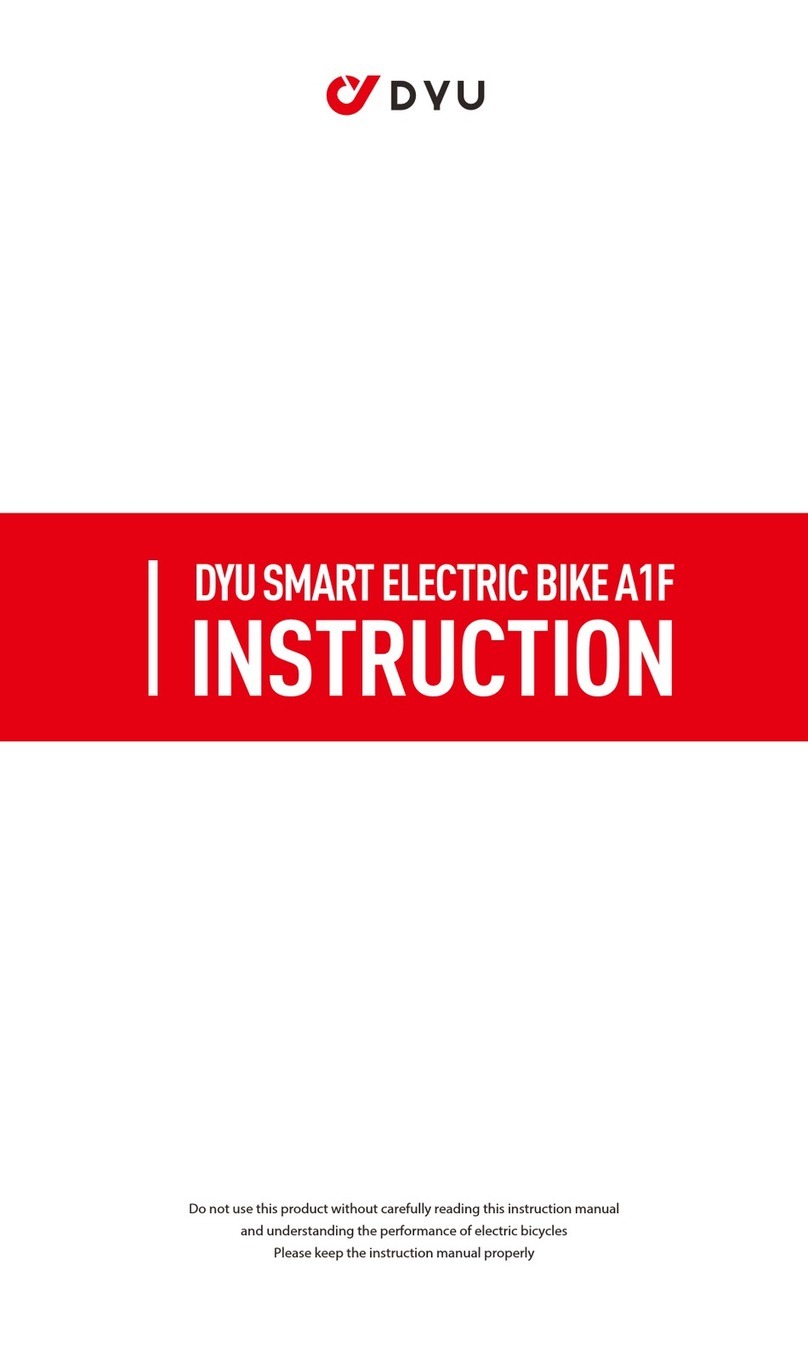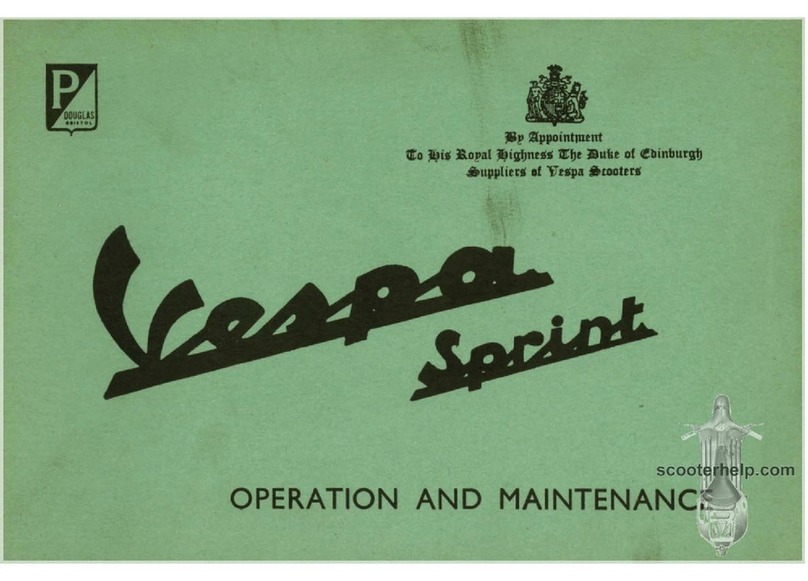GOVECS GO! S 1.2 User manual

1
GOVECS GO! S 1.2
www.govecs.com
USER’S MANUAL
AND SERVICE BOOK
BEDIENERHANDBUCH
KUNDENDIENSTSCHECKHEFT
MANUAL DEL USUARIO
Y EL LIBRO DE REVISIONES
MODE D’EMPLOI
MANUEL D’INSTRUCTIONS
MANUALE D’USO
E MANUTENZIONE
GEBRUIKERSHANDLEIDING
& SERVICE BOEK

GOVECS GO! S 1.2
www.govecs.com
USER’S MANUAL
AND SERVICE BOOK

4
E
N
Dear User of scooter GOVECS,
We are excited that you have made the decision to purchase a GOVECS scooter, and it is our
pleasure to welcome you among the great number of GOVECS’ scooter-cyclists.
This manual includes instructions concerning proper use, maintenance, and care of your scoot-
er GOVECS. For your own protection and provision of operation comfort we advice you careful
reading of this manual before first use.
Proper maintenance, observing all the instructions concerning the care and technique of opera-
tion, included in this manual and regular inspections in authorized sales outlets GOVECS are pre-
requisites of faultless operation, maintenance of its value and warranty.
Have a comfortable and accident free journey!

5
EN
Table of contents
1. Safety guidelines
1.1 Pre-ride activities
1.2 Clothing
1.3 Riding technique
1.4 Carrying cargo and passengers
1.5 After riding
Vehicle equipment
2.1 Left side of the vehicle
2.2 Right side of the vehicle
2.3 Operational elements
2.4 Ignition switch
2.5 Speedometer
2.6 Left side controllers
2.7 Right side controllers
2.8 Throttle
2.9 Trunk
2.10 Charging of the battery
2.11 Handle
2.12 Position the vehicle on the center
stand
2.13 Hook for bags
2.14 Lighting
2.15 Tires
2.16 Brakes
2.17 Controll of braking liquid level
2.18 Controll of belt tention
2.19 Technical specification
2.20 How to check the VIN number
2.21 Adjusting the rear shock
absorber
3. Taking care of the vehicle
4 . Transfer of the vehicle
4.1 Inspection before transfer of the
vehicle
4.2 Acceptance of the vehicle
4.3 Warranty terms
4.4 Technical inspection
5. Helpful Tips

6
E
N
1. Safety guidelines
1.1 Pre-ride activities
Before riding scooter make sure that:
• The charging plug is out of the socket
• The battery is suciently charged
• The lighting, turn signals, and horn function properly
• The mirrors are adjusted for proper use
• There is the correct air pressure and proper tread depth in tires
• The brakes work properly (braking test while pushing the scooter)
• There is the correct level of braking fluid and that the brake pads are not worn out
• It is easy to turn the handlebars without resistance, fully left and right
• There is proper belt tention
1.2 Clothing
• Always ride in proper clothes and proper helmet.
• Wear tight fitting and comfortable clothing
• Wear proper boots (don’t ride in high heels, flip-flops, or similar open footgear)
Inadequate clothing may become a threat to safe riding!

7
EN
1.3 Riding technique
• Vehicle should be ridden carefully and sensibly
• Always hold the handlebars with two hands
• While turning the rider and passenger should tilt along with the scooter
• Particular wariness is recommended while riding on poorly hardened or wet road surfaces
• Pay attention to atypical sounds or behavior of the scooter while riding
1.4 Carrying cargos and passengers
• In order to carry objects or bags one should explicitly use top case, under seat trunk or a
hook for bags. The maximum weight allowance for top case is 5 kg.
• Maximum scooter weight allowance must not be exceeded (150kg including passengers’
weight)
• The scooter is allowed to carry maximum 2 persons
1.5 After riding
• Check if the battery needs charging
Riding with low level of battery significantly decreases its life.
Battery life can be extended by recharging it each time with use of originally installed
GOVECS charger. There is no risk of overcharging, because after reaching maximum
charging level the charger disconnects automatically (even though the fen is still
working).

8
E
N
2. Vehicle equipment
2.1 Left side of the vehicle
1. Left mirror
2. Right mirror
3. Speedometer
4. Ignition switch
5. Single piece seat
6. Handle
7. Seat lock
8. Rear shock
absorber
9. Rear wheel
10. Center stand
11. Front wheel
11
10
9
8
7
6
5
6
5
4
5
4
3
4
2
3
2
1

9
EN
2.2 Right side of the vehicle
1. Brake lever
2. Head-light
3. Front turn signal
4. Hook for bags
5. Storage compartment under the seat
6. Cable for charging under the seat
7. Parking and
braking light
8. Rear turn signal
9. Engine
2
3
1
7
9
8
6
7
8
7
6
5
3
3
4

10
E
N
2.3 Operational elements
1. Right mirror
2. Speedometer
3. Handlebar throttle
4. Front wheel brake lever
5. Right side switches
6. Trip reset button
7. Ignition switch
8. Hook for bags
9. Left mirror
10. Rare wheel brake lever
11. Left side switches
12. Power socket 12V
1
3
3
4
3
5
10
12
1
0
11
2
4
6
5
7
5
6
7
8
9

11
EN
2.4 Ignition switch
Turned o
• All the functions turned o
• Handlebar is not locked
• Scooter can be rolled
• Scooter can be safely handled
Riding position (vehicle turned on)
• All the functions active
• Scooter is ready for riding
• Taking out the key in this position is not possible
• The key should be turned to riding position only
after the rider is seated on the vehicle, directly
before riding.
Note:
The sound of the engine is not heard although
the handlebar throttle is active.
Ignition on
Riding position

12
E
N
Handlebar locked
Ignition switch position „Handlebar locked”
• All the functions turned o
• The handlebar locked
• Scooter can be safely handled
Locking handlebar
1. Turn the handlebar left all the way to the end
2. Push in the key turning it left at the same time
to the padlock position
3. Pull out the key

13
EN
2.5 Speedometer
Speedometer is equipped with the
following functions and indicators
1. Head light
2. Right turn signal
3. Riding speed
4. Charging battery indicator
5. Selection button [Select]
6. Mode button [Mode]
7. Clock
8. Kilometres: total / daily
9. Left turn signal
10. Battery signal light
11. Charging indicator
4
4
3
3
2
6
7
7
8
5
3
2
1
11
10
9

14
E
N
Controllers handling
Switching between total kilometers (odo) and daily kilometres (trip)
Holding pressed mode button [mode] (6) for one second switches from total kilometers count
(odo) to the dialy kilometers one (trip) .
Pressing Trip reset button results in resetting the trip meter. In case your scooter doesn’t have
the button, pushing in the selection button for 3 seconds [select] (5) will give the same result.
Pressing the mode [Mode] (6) and selection [Select] (5) buttons for 3 seconds switches speed
unit from km/h to mph (miles per hour) or vice-versa.
Setting the clock
In order to set up the clock keep pressing the mode [Mode] (6) button until the minutes value
begins to pulsate.
Then set up the minutes by pushing in the selection [Select] (5) button.
After pushing in mode button [Mode] (6) again the hour value begins to pulsate and the hour
can be set. In order to confirm the setting, the mode button [Mode] (6) should be pushed in
again.

15
EN
2.6 Left side controllers
1. Running light / head light switch
2. Turn signal button (for canceling)
3. Turn signal switch
4. Motor – horn button
Turn light is on by moving to the left
or to the right the turn light switch (3)
according to intended riding direction.
In order to turn o the turn lights their
button should be turned o (2).
4
3
2
1

16
E
N
2.7 Right side controllers
1. On/O economy function switch
• Economy function allows an
increase of vehicle distance
range.
• Setting the switch to „on”
position slightly reduces the
acceleration of the scooter, at
the same time lowers the use of
energy, thus increasing the range
of the scooter.
2. Safety kill switch
• This kill switch MUST be moved
to the left hand side position
when the ignition key is being
turned on! After ignition is turned
on, move the kill switch to the
right hand side position. Scooter
is activated. Failure to do so will
display the error code F-0884 on
the speedometer.
The Economy function should only be turned ON and OFF when the vehicle is
parked, but the ignition must not be turned o! Economy function does not
aect maximum speed!
2
1

17
EN
2.8 Throttle
By turning of handlebar throttle (1) the speed
can be controlled.
2.9 Trunk
1. Trunk
2. Seat lock
• In order to unlock the seat the key
should be inserted and turned left, then
the seat will raise up.
• In order to close the seat push the seat
in the middle until you hear the lock
click
• Maximum load of the trunk is 5 kg.
Note!
Never place the key in the trunk before
locking the seat
Please take care of the charging cable
when closing
1
2
Handlebar throttle
Trunk
1

18
E
N
2.10 Charging of the battery
1. Charging cable (in trunk under the seat)
2. Plug CEE7-VII at the end of charging cable
Charging cable can be used for all sockets type
E/F or CEE 7/4 with specification 16A/250V.
Charging time of empty battery amounts to
about 4-5 hours. Battery should be charged
each time it is possible since it extends its
lifetime.
Avoid riding with not fully charged battery
since it decreases its lifetime. There is no
possibility to overcharge the battery.
Important note: battery requires to be
charged at least once a month, even if
you do not use your scooter.
1
2

19
EN
2.11 Handle
Handle (1) allows passenger to hold during
riding. Moreover, the handle is helpful while
position the vehicle on center stand.
2.12 Position the vehicle on the
center stand
1. In order to support the vehicle on stand
one should press down the catch of the
center stand from the left side of the
scooter (arrow 1)
2. Both legs of center stand must stand on
the surface (arrow 2)
3. Press down the catch of the center stand
at the same time pull backward and
upward the handle until the scooter is
safely supported on the center stand.
Don’t sit on the scooter while it is
supported on the stand since it may
damage the vehicle!
Position on center stand
Handle
1
3
3
1
1
2
2

20
E
N
2.13 Hook for bags
Hook for bags (1) can be used to hang bags e.g. Bags or
bags with shopping.
Hook has protection, which prevents unfastening and
loosing the bag.
In order to hang a bag the operator should expand the
hooks in directions showed with arrows.
Remember that while turning the swinging bags
may aect riding.
Do not hang weights exceeding 3 kg on the hook.
2.14 Lighting
Each time, before riding the lighting installation should be checked in respect of its
functionality, damages, and settings.
• Head-light and parking light
• Front and rear turn signals
• Tail light
• Brake light for front and rear brake
• Number-plate light
Due to the fact that the LED energy-saving bulbs were used in GOVECS scooters, in case
of abnormal functioning or damage of lighting installation, its repair should be ordered
at sales center of GOVECS.
Hook for bags
1

21
EN
2.15 Tires
It is necessary to check tires before riding for possible damages or lack of air.
Too low air pressure or worn out tires have a negative impact on the scooter’s performance
during riding and reducing the scooters’ range.
Tires can be replaced only at the GOVECS sales center.
Air pressure in tires can be checked and adjusted at every petrol station. Pressure in tires should
be checked once a week and after longer periods of downtime.
Airpressure Without load With load (2 persons)
Front 2,5 bar 2,6 bar
Rear 2,5 bar 2,8 bar
Table of contents
Languages:
Other GOVECS Scooter manuals
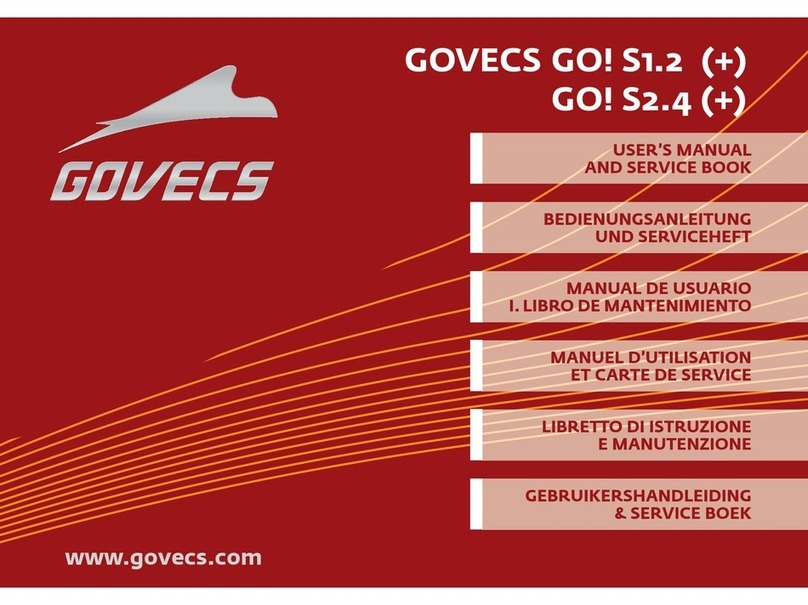
GOVECS
GOVECS GO! S2.4 User manual

GOVECS
GOVECS FLEX 2.0 User manual
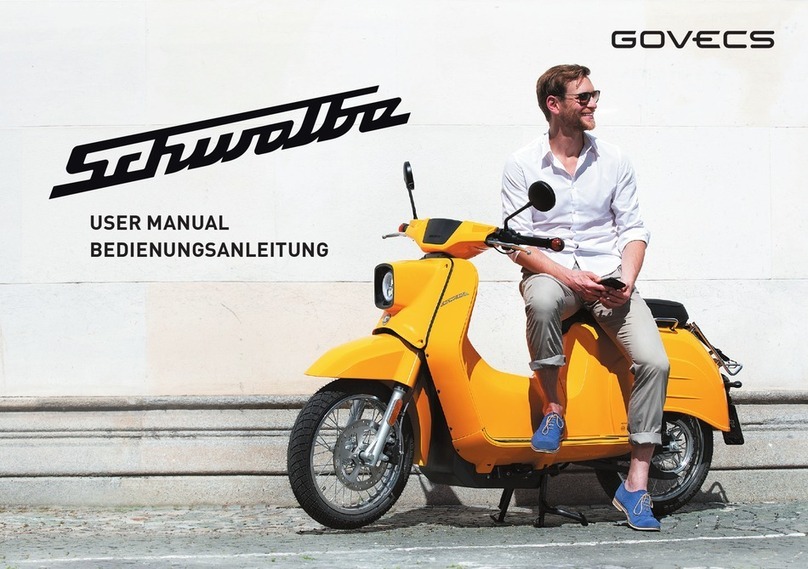
GOVECS
GOVECS Schwalbe User manual
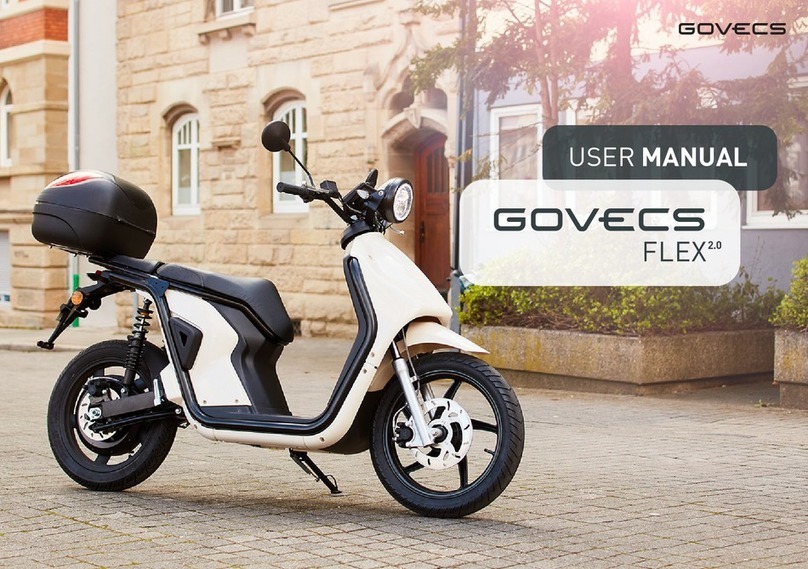
GOVECS
GOVECS FLEX 2.0 User manual
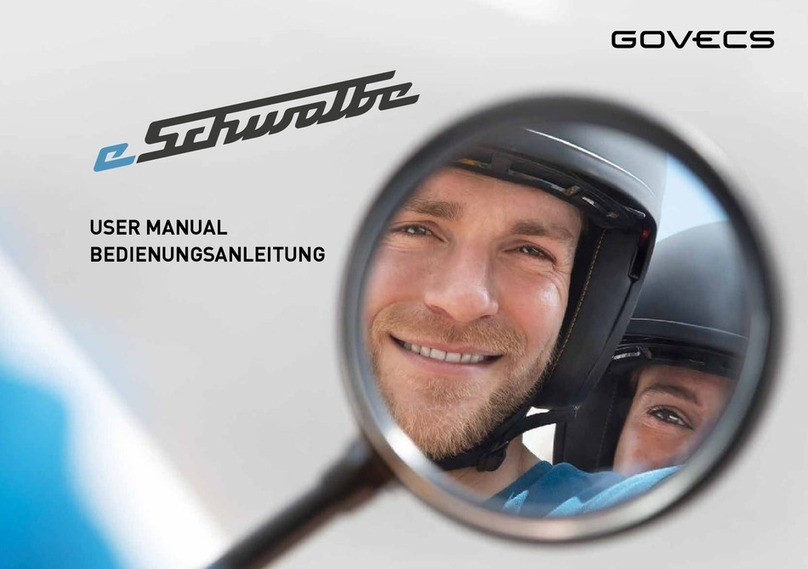
GOVECS
GOVECS E-Schwalbe 2023 User manual

GOVECS
GOVECS ELM OTO KICK User manual

GOVECS
GOVECS FLEX 2.0 User manual
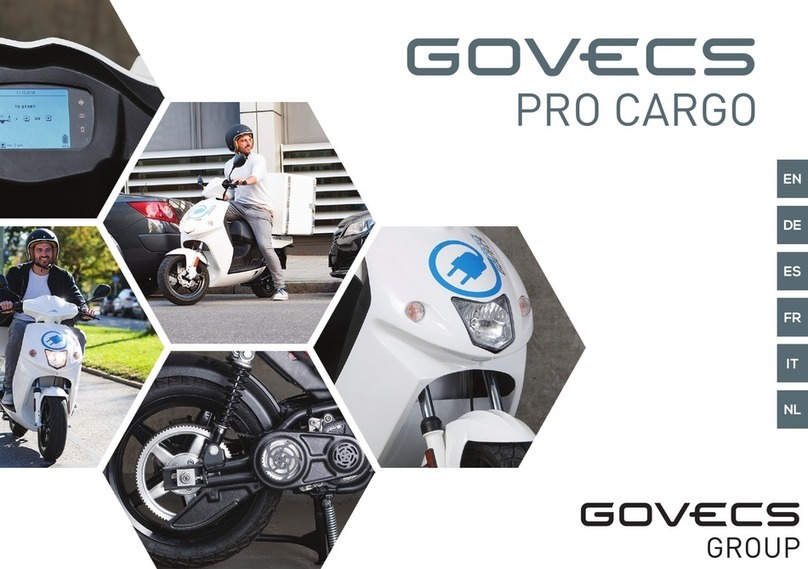
GOVECS
GOVECS PRO CARGO User manual

GOVECS
GOVECS FLEX User manual

